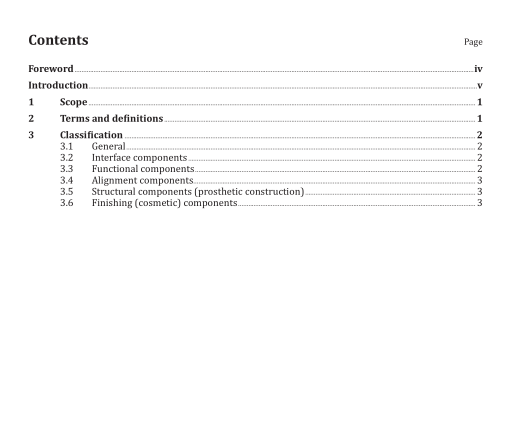BS ISO 13405-1:2015 pdf download.Prosthetics and orthotics — Classification and description of prosthetic components Part 1 : Classification of prosthetic components
This part of ISO 13405 specifies a means of classifying the components of limb prostheses and their
construction.
2 Terms and definitions
For the purposes of this document, the following terms and definitions apply.
2.1 axial stabilization
attribute of interface components which relates to the transmission of longitudinal (proximally directed) forces from the prosthesis to the body
2.2 transverse stabilization
attribute of interface components which relates to the transmission of transversely directed forces between the prosthesis and the body
Note 1 to entry: Three forms of stabilization are required: anteroposterior, mediolateral, and rotational.
2.3 suspension
attribute of interface components concerned with the retention of the prosthesis on the body, i.e. the transmission of longitudinal (distally directed) forces from the prosthesis to the body
2.4 adjustable component
prosthetic component whose features can be changed before use by the manufacturer, prosthetist, or user
2.5 adaptable component
prosthetic component whose features can be changed by the user to make it suitable for different situations
2.6 auto-adaptive component
prosthetic component whose features change automatically in response to varying situations
2.7 liner
removable lining worn between the stump and the inner surface of the socket
Note 1 to entry: It is used to modify the distribution of the forces associated with axial and transverse stabilization and it can additionally form a part of the prosthetic suspensory system.
3 Classification
3.1 General
Prostheses are externally applied devices used to replace wholly, or in part, an absent or deficient limb segment. They are integrated constructions comprising the following classes of components:
a) interface components;
b) functional components;
c) alignment components;
d) structural components;
e) finishing (cosmetic) components.
NOTE Some components can belong to more than one class, e.g. alignment components can also serve as structural components.
3.2 Interface components
Interface components of a prosthesis are in direct contact with the wearer. They are the means of achieving axial stabilization, transverse stabilization, and suspension (see Clause 3). Interface components include:
a) the socket;
b) suspensory components, which maintain the prosthesis relative to the body;
c) the liner.
NOTE Interface components can contain elements which contribute to the activation and/or control of functional components.
3.3 Functional components
3.3.1 Functional components of a prosthesis substitute for some of the dynamic and sensory attributes of the normal limb.
3.3.2 Lower limb prosthetic functional components include:
a) ankle-foot units;
b) knee units;
c) hip units;
d) torque reducers;
e) load attenuators (shock absorbers);
f) turntables;
g) external (side) joints.
3.3.3 Upper limb prosthetic functional components include:
a) terminal devices and digits;
b) wrist units;
c) elbow units;
d) shoulder units;
e) turntables;
f) external (side) joints.
3.4 Alignment components
Alignment components of prosthesis permit changes in the position of its components relative to one another.
3.5 Structural components (prosthetic construction)
The structural components of prosthesis connect the interface, functional, and alignment components,and maintain the integrity of the prosthesis. Types of prosthetic construction include:
a) endoskeletal: in which the structural components are internal and can be covered by finishing the components,
b) exoskeletal: in which the structural components are external and also constitute the shape of the prosthesis.
3.6 Finishing (cosmetic) components
Finishing components of prosthesis can simulate the appearance, and/or texture, and/or consistency of a normal limb. They include:
a) cosmetic fillers and shells, which provide the desired shape of the prosthesis and can simulate the consistency of soft tissue;
b) prosthetic skins, stockings, and gloves, which compose the outermost layer of the prosthesis and can simulate the colour, and/or texture of the human skin.BS ISO 13405-1 pdf download.BS ISO 13405-1 pdf download
